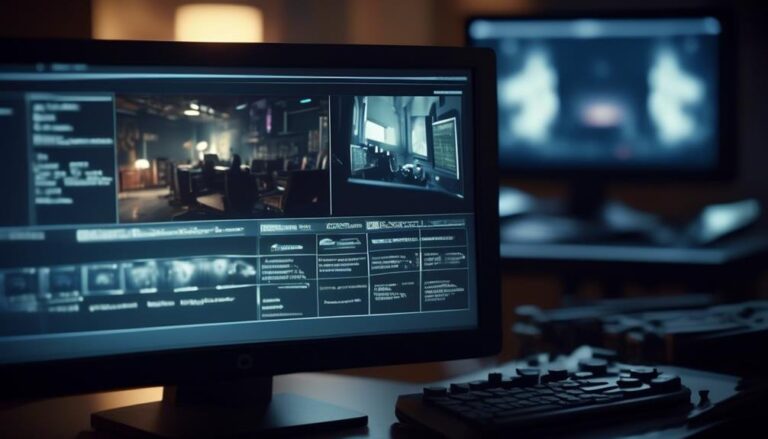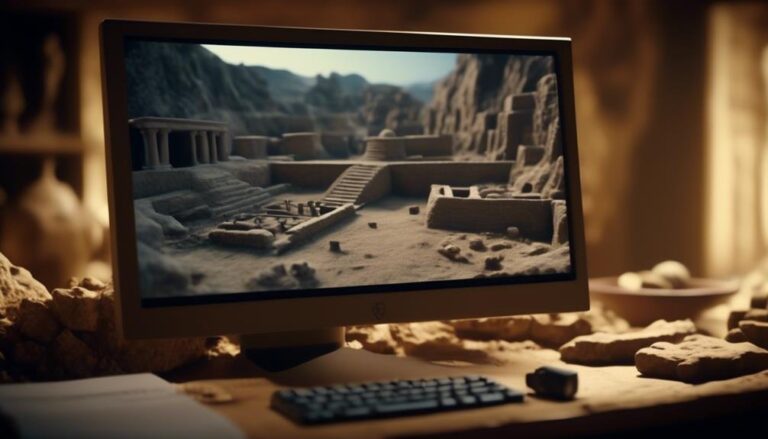The Best Online Animation Courses for Aspiring Animators
Wondering if online animation courses can truly equip you with the skills you need to break into the industry? Look no further.
With the abundance of online courses available, it can be overwhelming to find the ones that are worth your time and investment. However, there are a few standout options that have gained recognition for their quality and effectiveness.
Whether you're interested in traditional 2D animation, 3D character animation, or motion graphics, there are courses out there that can provide you with the knowledge and skills necessary to pursue your dream career in animation.
Key Takeaways
- Animation principles and techniques such as 'squash and stretch', 'anticipation', 'staging', 'follow through and overlapping action', and 'slow in and slow out' are fundamental for creating realistic and engaging animations.
- Storyboarding and visual development are crucial for conveying narrative and emotions effectively in animation.
- Understanding visual design techniques, including color theory and composition, can greatly enhance the impact and storytelling of animated projects.
- Learning motion graphics and special effects can add depth, realism, and visual appeal to animations, while game design and interactive media offer opportunities for creating interactive and immersive experiences through animation.
Traditional Animation Fundamentals
If you're new to traditional animation, understanding the fundamentals is essential for building a strong foundation in this timeless art form. Traditional animation principles form the backbone of this craft, emphasizing the importance of conveying believable movement and emotion through frame by frame animation techniques.
The first fundamental principle is 'squash and stretch,' which involves deforming the character to show its weight and flexibility.
Then there's 'anticipation,' preparing the audience for an upcoming action. 'Staging' directs the audience's attention to the most crucial elements in a scene, while 'follow through and overlapping action' create a more realistic and fluid motion.
'Slow in and slow out' adds a natural and dynamic feel to the animation. 'Arcs' ensure smooth and natural movements, and 'timing' dictates the speed and rhythm of the animation.
3D Character Animation Techniques
Explore advanced techniques for bringing 3D characters to life through dynamic and expressive animation. In this course, you'll delve into character rigging, an essential skill for animators, which involves creating a digital skeleton for the character, allowing for realistic movement and posing.
You'll also learn advanced animation techniques to make characters move in a lifelike manner, focusing on body mechanics and the principles of motion. Understanding how weight and balance affect movement is crucial for creating convincing character animations.
Moreover, this course will cover the intricacies of facial expressions, teaching you how to manipulate the character's face to convey emotions effectively. Mastering facial animation is key to breathing life into characters and making them relatable to the audience.
Through hands-on projects and exercises, you'll develop the skills needed to create compelling character performances. By the end of this course, you'll have a solid grasp of the techniques involved in bringing 3D characters to life and be well-prepared to tackle complex animation projects.
Storyboarding and Visual Development
Now it's time to focus on the essentials of storytelling with storyboard basics and visual design techniques. You'll learn how to bring your ideas to life by creating compelling visual narratives and refining your artistic skills.
These foundational aspects are crucial for setting the stage and communicating your vision in the animation industry.
Storyboard Basics
Start by understanding the fundamental principles of storyboard basics, which are essential for visual development in animation. Mastering storyboard techniques and visual storytelling is crucial for bringing a story to life through animation.
Here are three key elements to consider:
- Clarity: Clear and concise storyboards help in effectively conveying the narrative and emotions to the audience, making the storytelling more impactful.
- Emotional Impact: A well-crafted storyboard has the power to evoke emotions, immerse viewers in the narrative, and create a strong connection with the characters.
- Visual Flow: Understanding visual flow within a storyboard is essential for maintaining the audience's engagement and guiding their focus throughout the animation.
Visual Design Techniques
To enhance your understanding of visual design techniques in animation, mastering the art of storyboard basics is crucial for bringing your creative visions to life. By delving into the world of color theory and composition, you'll learn how to evoke specific emotions and moods through the visual elements in your animations. Understanding how colors interact and the principles of composition will empower you to create visually compelling stories that captivate your audience. Here's a table to illustrate the emotional impact of different color choices:
| Color | Emotion |
|---|---|
| Red | Passion, Energy |
| Blue | Calm, Serenity |
| Yellow | Happiness, Optimism |
| Green | Growth, Renewal |
| Purple | Luxury, Mystery |
Mastering visual design techniques will enable you to craft captivating and emotionally resonant animations.
Motion Graphics and Special Effects
Explore the techniques for creating motion graphics and special effects in our online animation courses. Learn how to bring your animations to life with dynamic motion graphics and captivating special effects that will elevate your work to the next level.
Our courses cover a wide range of topics related to motion graphics and special effects, including:
- Mastering Animation Techniques: Dive into the world of animation and learn how to create seamless motion graphics that enhance the storytelling in your projects. From basic principles to advanced techniques, you'll gain the skills needed to make your animations visually compelling.
- Implementing Visual Effects: Discover how to integrate stunning visual effects into your animations, adding depth and realism to your work. Whether it's creating explosions, magical effects, or futuristic environments, our courses will teach you the tools and methods to achieve professional-grade visual effects.
- Enhancing Character Design: Explore how to use motion graphics and special effects to enhance character design, bringing personality and emotion to your animated creations. You'll learn how to use effects to convey movement, expressions, and unique traits, making your characters truly come alive on the screen.
In our online animation courses, you'll gain the expertise needed to create captivating motion graphics and mesmerizing special effects that will impress audiences and elevate your animations to new heights.
Game Design and Interactive Media
You'll learn the fundamentals of game design and interactive media, including the tools and techniques used in the industry.
These courses will cover the basics of game design, interactive media tools, and animation specifically tailored for games.
You'll gain practical skills that will prepare you to create engaging and interactive experiences for a variety of platforms.
Game Design Basics
Interested in learning the fundamentals of game design and interactive media? Here are three key aspects you should focus on to gain a solid understanding:
- Game design principles and level design: Understanding the principles of game design is crucial for creating engaging and immersive experiences. Learn how to craft levels that challenge and entertain players, keeping them invested in the game world.
- Game mechanics and player experience: Delve into the core mechanics that drive gameplay and define the overall player experience. Mastering this aspect will enable you to create games that aren't only enjoyable but also provide a meaningful and memorable experience for the players.
- Interactive storytelling and narrative design: Explore the art of weaving compelling narratives into interactive experiences, allowing players to become fully immersed in the game world.
Interactive Media Tools
To enhance your understanding of game design and interactive media, familiarize yourself with a variety of interactive media tools that can streamline your creative process and elevate the quality of your projects.
When delving into game design and interactive media, having the right tools at your disposal is essential. Animation software essentials like Adobe Animate, Toon Boom Harmony, and Blender are widely used in the industry for creating interactive media. These programs offer a range of features such as timeline-based animation, rigging tools, and special effects capabilities that are crucial for developing compelling interactive content.
Additionally, game engines like Unity and Unreal Engine provide powerful platforms for designing and building interactive experiences.
Animation for Games
Mastering the use of animation software essentials like Adobe Animate, Toon Boom Harmony, and Blender is crucial for creating compelling interactive content for games and other interactive media projects. When delving into game animation, understanding the principles of movement and character design becomes paramount.
Here are three key aspects to focus on when diving into animation for games:
- Fluidity and Realism: Capturing the essence of natural movement in characters and environments can deeply engage players and enhance the overall gaming experience.
- Expressive Character Design: Creating characters with distinct personalities and traits through animation can evoke emotions and forge strong connections between players and the game world.
- Interactive Animation Techniques: Learning how to integrate animations that respond to player actions can make the game world feel dynamic and immersive.
Stop Motion Animation Mastery
How can you achieve mastery in stop motion animation?
Mastering stop motion animation involves honing your skills in various stop motion techniques and mastering the art of creative storytelling. To excel in stop motion, it's crucial to grasp the fundamentals of frame-by-frame animation, puppetry, and object manipulation. Understanding the nuances of lighting, composition, and set design is also essential in creating captivating stop motion sequences.
In addition to technical skills, mastering stop motion animation requires a deep understanding of creative storytelling. You must learn how to convey emotions, plot, and character development through the movement of inanimate objects. This involves developing a keen eye for detail and the ability to evoke a sense of realism and personality in your creations.
To achieve mastery in stop motion animation, consider enrolling in online courses that offer comprehensive training in stop motion techniques and storytelling. Look for courses that provide hands-on projects, expert guidance, and opportunities to collaborate with other aspiring animators. By continually practicing and refining your skills, you can work towards becoming a proficient stop motion animator capable of bringing imaginative stories to life through this unique animation medium.
Industry-Standard Software Training
As you advance your skills in stop motion animation, exploring industry-standard software training can elevate your proficiency and expand your creative capabilities. Learning to master software such as Adobe Animate, Toon Boom Harmony, and Autodesk Maya can significantly enhance your animation portfolio building, opening up freelance opportunities and showcasing your expertise to potential clients or employers.
These industry-standard software tools are widely used in the animation industry, so acquiring proficiency in them won't only improve your skills but also increase your market value.
Moreover, delving into industry-standard software training provides you with the chance to network and establish industry connections. Many online courses offer forums, virtual events, and networking opportunities where you can connect with fellow animators, industry professionals, and potential collaborators.
Building a strong network within the animation industry can lead to valuable connections, mentorship opportunities, and even job prospects in the future.
Conclusion
Now that you've explored the best online animation courses, it's time to bring your creative vision to life. With dedication and the right skills, you can turn your passion for animation into a successful career.
So, get ready to blend imagination with technology, and bring characters and stories to life in ways that will captivate audiences. The journey may be challenging, but the rewards will be worth every effort.
Get started and make your dreams a reality!







